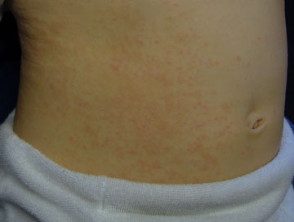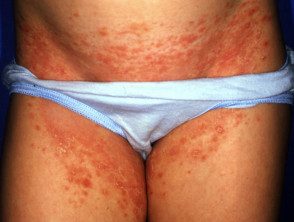What is the thoracic thoracic? exanthema?
Late thoracic rash is rare eruption affecting young children, suspected to be caused by a virus infection.
The late thoracic rash is also known as the Asymmetric Periplexural Exanthem of Childhood (APEC). A new name has been proposed: childhood superimposed lateralized rash (2014).
Who gets the thoracic rash?
The posterior thoracic rash affects twice as many girls as boys. The average age is two years, most cases are between one and five years old.
What is the cause of the late thoracic rash?
Occasionally, a specific virus has been associated with a late thoracic rash. After looking at a case associated with adenovirus reported in 2014, the authors speculated that early postzygotic mutation It has made the skin on one side of the body more reactive to an infectious agent. Subsequent involvement on the other side of the skin reflects less reactive skin on that side.
Clinical characteristics of late thoracic rash
Late thoracic rash occurs mainly in winter and spring, as is common in viral infections. It has been specifically associated with Epstein-Barr virus, adenovirus, and parvovirus B19.
The rash is often mistaken for eczema (dermatitis) or a fungal infection (ringworm). It usually begins in the armpit or groin and gradually extends outward, staying predominantly on one side of the body. It can spread to the face, genitals, hands, or feet.
The posterior thoracic rash begins as a small raised rose papules, which may be surrounded by a pale halo. These become flat and scaly over the next week or two. Half of the older patches fade to a dark gray. Occasionally, the patches are net or ring shaped. Small blisters or blood spots may appear. The rash is usually quite itchy.
Sometimes other features of the viral infection present at the start of the rash, such as a fever, sore throat, cold, vomiting and / or diarrhea. The lymphatic glands in the armpits and groin can become enlarged.
APEC



The rash lasts for several weeks, but always resolves spontaneously within three months.
Treatment of late thoracic rash
The late thoracic rash disappears without treatment. Itchiness can be alleviated with:
- Emollients
- Current steroids
- Oral antihistamines

